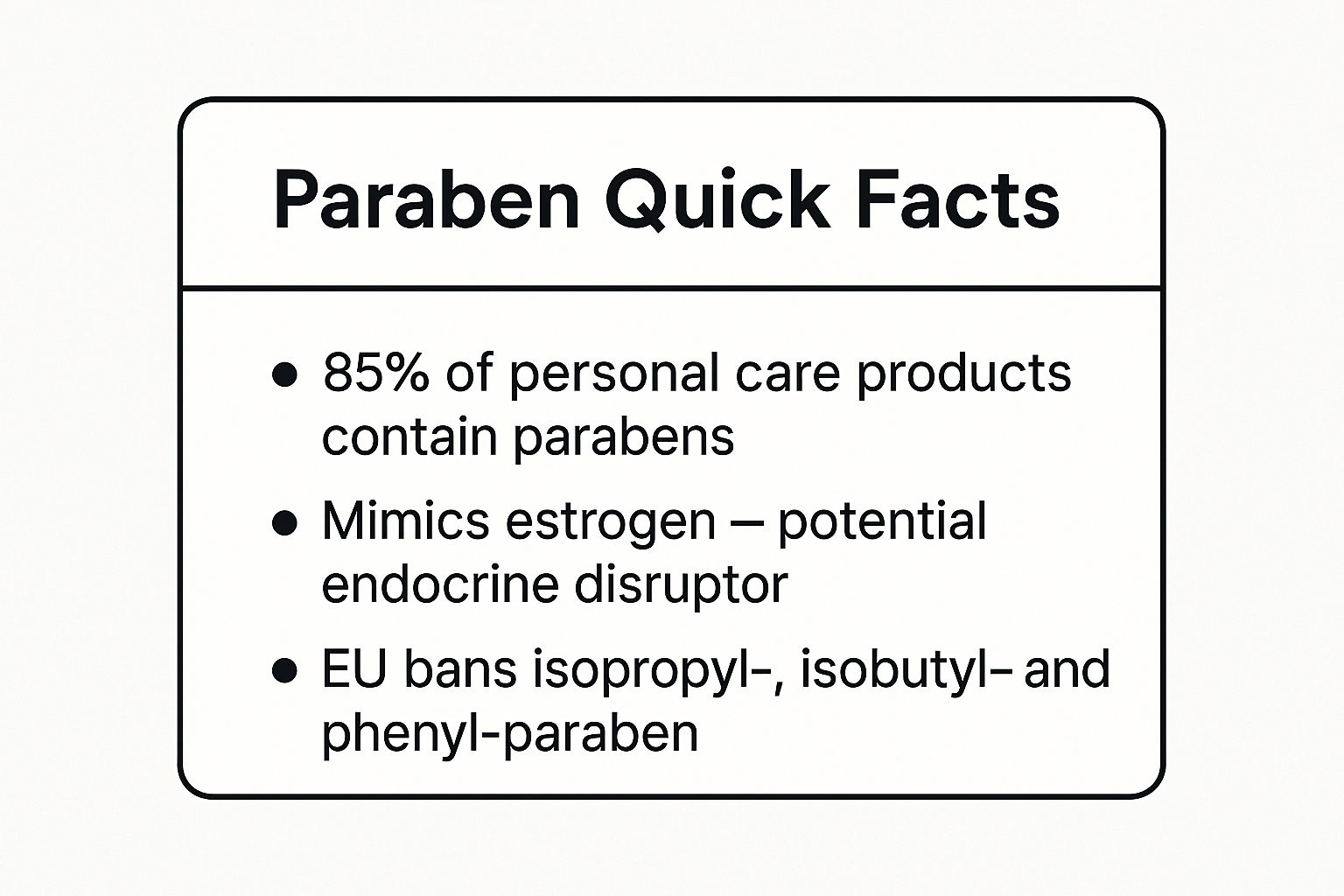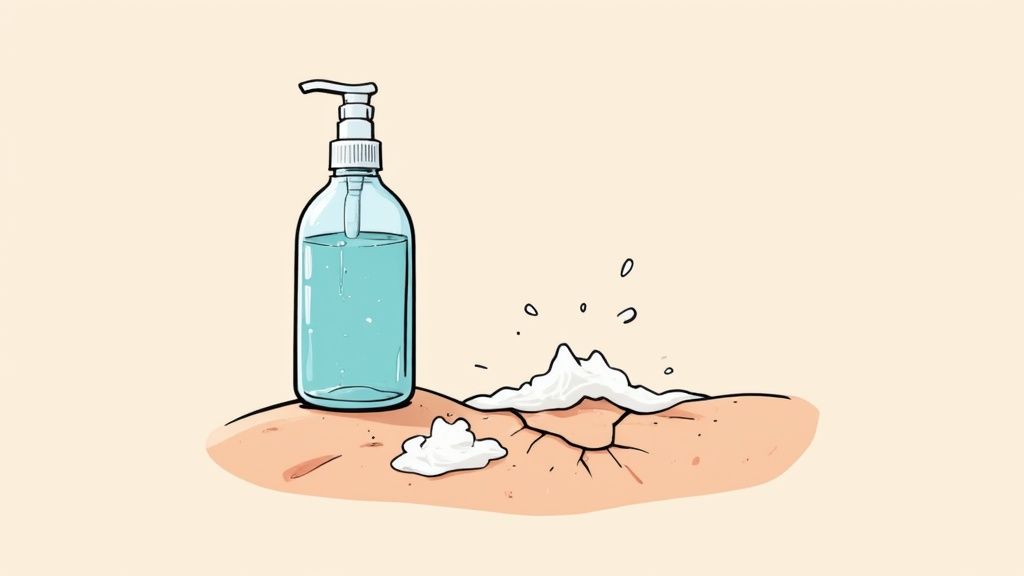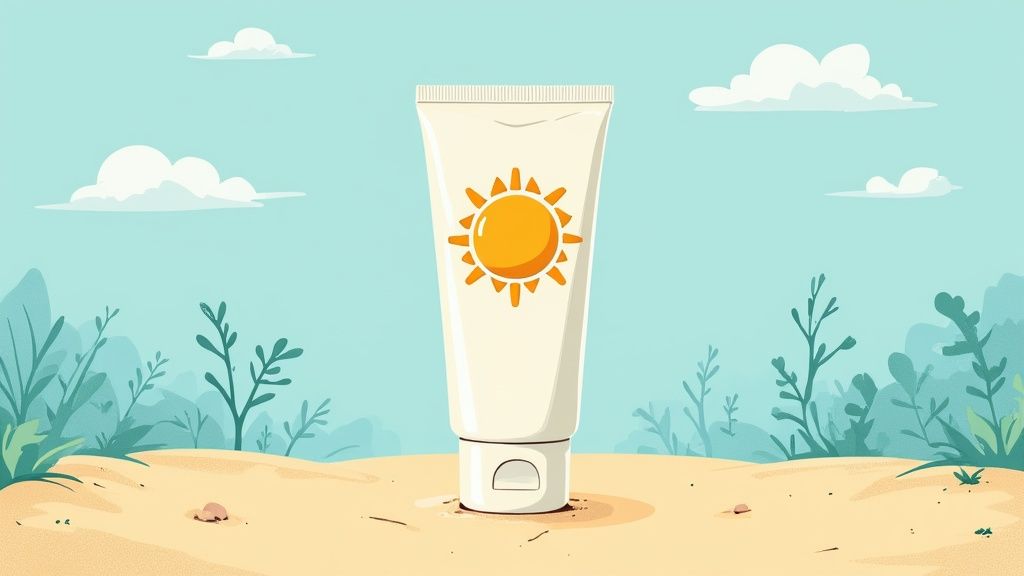Navigating the world of skincare can feel like a chemistry class you never signed up for. With ingredient lists running dozens of lines long, it's easy to feel overwhelmed and unsure if the products you trust are truly safe for your family. Many common formulations, from drugstore moisturizers to luxury serums, contain chemicals that can disrupt hormones, strip the skin's natural moisture barrier, and trigger inflammation. This is especially true for those with dry, sensitive, or reactive skin.
Understanding what to look for is the first step toward a cleaner, more effective routine. This guide cuts through the noise and gets straight to the point. We will identify the most problematic skin care ingredients to avoid and explain exactly why they don't belong on your skin or in your home. We'll equip you with the knowledge to read labels like a pro, helping you make informed choices for yourself and your loved ones. The goal is to cultivate a routine that genuinely nurtures your skin's long-term health, moving beyond temporary fixes to build a foundation of true, gentle radiance. Let's dive into the specifics of what to leave on the shelf.
1. Parabens (Methylparaben, Propylparaben, Butylparaben)
Parabens are a group of synthetic preservatives that have been widely used in cosmetics, skincare, and even food products since the 1920s. Their primary function is to prevent the growth of harmful bacteria, mold, and yeast, which significantly extends the shelf life of your favorite creams and lotions. You'll commonly find them listed on ingredient labels as methylparaben, propylparaben, and butylparaben.
The main concern surrounding these ingredients stems from their ability to mimic estrogen in the body. Because they can be absorbed through the skin, this hormone-like activity classifies them as potential endocrine disruptors. While regulatory bodies like the U.S. FDA consider them safe at current exposure levels, their presence in breast cancer tumors has prompted many consumers to seek paraben-free alternatives as a precautionary step. This is a key reason why they top our list of skin care ingredients to avoid.
The infographic below offers a quick summary of why parabens are under scrutiny.

As the data highlights, the widespread use of parabens combined with their potential to disrupt hormones makes them a controversial ingredient. This has led to stricter regulations in some parts of the world and a surge in consumer demand for safer products.
How to Spot and Avoid Parabens
Identifying and avoiding parabens requires a bit of label-reading diligence, but it’s straightforward once you know what to look for.
- Check the Label: The simplest method is to look for products explicitly marked "paraben-free". Many brands now use this as a key marketing point.
- Scan the Ingredient List: If a product isn't labeled, scan the full ingredient list for any chemical ending in "-paraben." Common culprits include methylparaben, ethylparaben, propylparaben, and butylparaben.
- Beware of "Fragrance": The term "parfum" or "fragrance" on a label can sometimes hide parabens, which may be used to preserve the scent blend. Opting for fragrance-free products can help you avoid this loophole.
- Understand Alternatives: Brands are increasingly using preservatives like phenoxyethanol, sodium benzoate, or natural options like rosemary extract. Be aware that products with natural preservatives may have a shorter shelf life and should be stored properly.
2. Sulfates (Sodium Lauryl Sulfate/SLS, Sodium Laureth Sulfate/SLES)
Sulfates are powerful detergents, known as surfactants, responsible for the satisfying, rich lather in many facial cleansers, body washes, and shampoos. Their main job is to bind with oil, dirt, and grime, allowing them to be easily washed away with water. The most common types you'll see on labels are Sodium Lauryl Sulfate (SLS) and Sodium Laureth Sulfate (SLES).
The controversy with sulfates lies in their aggressive cleansing action. While highly effective, they can strip the skin of its natural, protective oils, disrupting the delicate moisture barrier. This can lead to dryness, irritation, redness, and increased sensitivity, particularly for those with pre-existing conditions like eczema or rosacea. Because they can be so stripping, sulfates are a primary example of skin care ingredients to avoid for anyone with compromised or sensitive skin.

The potential for irritation has led many dermatologists and brands like Youth to the People to advocate for sulfate-free formulas. Furthermore, the manufacturing process for SLES, called ethoxylation, carries a risk of contamination with 1,4-dioxane, a potential carcinogen.
How to Spot and Avoid Sulfates
Avoiding sulfates is becoming easier as more brands move toward gentler cleansing agents. A quick check of the label is your best strategy.
- Look for "Sulfate-Free": Many products prominently display this claim on their packaging, making them easy to identify. Brands like CeraVe and The Ordinary have built a reputation on offering gentle, sulfate-free cleansers.
- Read the Ingredient List: Scan for Sodium Lauryl Sulfate and Sodium Laureth Sulfate near the top of the ingredient list. Their position indicates their concentration in the formula.
- Embrace Gentler Alternatives: Look for cleansers formulated with milder surfactants. Ingredients like cocamidopropyl betaine, decyl glucoside, or coco-glucoside clean effectively without the harsh stripping effect.
- Protect Your Skin Barrier: If you must use a product with sulfates, limit the contact time on your skin, rinse it off thoroughly, and immediately follow up with a nourishing moisturizer to help replenish the skin's barrier. This is a crucial step in a proper sensitive skin care routine.
3. Fragrance/Parfum
Listed simply as "fragrance" or "parfum," this single term on an ingredient label can represent a complex mixture of dozens, or even hundreds, of undisclosed chemical compounds. This is possible due to a "trade secret" loophole in labeling laws that allows manufacturers to protect their signature scents without revealing the specific ingredients. Fragrance is a leading cause of allergic contact dermatitis and skin sensitivity, making it one of the most important skin care ingredients to avoid, especially for those with reactive or delicate skin.
The primary issue is the lack of transparency. Without a full ingredient list, consumers cannot identify potential irritants or allergens. Research by the Environmental Working Group (EWG) found that approximately 75% of products listing "fragrance" contained phthalates, which are potent endocrine disruptors linked to various health concerns. This ambiguity is why many dermatologists now operate fragrance-free offices and advocate for unscented products.

This growing awareness, championed by organizations like the Campaign for Safe Cosmetics, has pushed for greater accountability. In the EU, for example, brands are required to declare 26 known allergenic fragrance components. The rise of clean beauty retailers like Credo Beauty, which demand full fragrance disclosure from their brands, signals a shift toward a more transparent and safer market for consumers.
How to Spot and Avoid Fragrance/Parfum
Navigating the world of scented products requires a keen eye and a commitment to reading labels carefully. Here’s how to effectively steer clear of hidden irritants.
- Look for "Fragrance-Free": The most reliable choice is a product explicitly labeled "fragrance-free." Be cautious with "unscented" products, as they may contain masking agents to neutralize the smell of other ingredients.
- Scan the Ingredient List: Always check the full ingredient list for the words "fragrance," "parfum," "aroma," or "flavor." If you see any of these, it's best to avoid the product if you have sensitive skin.
- Prioritize Transparency: Choose brands that voluntarily disclose all their scent ingredients. If you enjoy a scented product, look for ones scented only with clearly listed essential oils, and remember to patch-test first. You can explore some of the best fragrance-free moisturizers on wildtallow.com to find gentle options.
- Differentiate Product Types: Be especially vigilant with leave-on products like moisturizers and serums, as they have prolonged contact with your skin. Fragrance in rinse-off products like cleansers is slightly less risky but can still cause irritation.
4. Formaldehyde and Formaldehyde-Releasing Preservatives
Formaldehyde is a well-known human carcinogen that is sometimes used as an industrial-strength preservative in skincare and cosmetic products. While it is rarely added directly to formulas anymore, many products contain what are known as formaldehyde-releasing preservatives (FRPs). These chemicals slowly break down over time, releasing small amounts of formaldehyde to prevent the growth of bacteria and extend shelf life.
The primary concern with these ingredients is their link to allergic skin reactions, contact dermatitis, and sensitization. The International Agency for Research on Cancer classifies formaldehyde as a known human carcinogen, raising significant safety questions about long-term, cumulative exposure through personal care products. This risk is why formaldehyde and its releasers are high on the list of skin care ingredients to avoid, particularly for those with sensitive skin or compromised skin barriers.
This has led to a major push for safer, non-toxic alternatives. Consumers are increasingly seeking out brands that formulate with their health in mind. For those interested in this movement, you can explore more about chemical-free skincare products on wildtallow.com to understand the benefits of simpler formulations.
How to Spot and Avoid Formaldehyde Releasers
Avoiding formaldehyde requires diligent label reading, as these ingredients are hidden behind complex chemical names. Here’s what to look out for.
- Scan for Key Culprits: Check the full ingredient list for common formaldehyde-releasing preservatives such as DMDM hydantoin, diazolidinyl urea, imidazolidinyl urea, quaternium-15, and bronopol.
- Be Wary of Hair Treatments: Keratin and hair straightening treatments are notorious for containing high levels of formaldehyde, even when marketed as "formaldehyde-free." Look for "methylene glycol" on the label, which is essentially formaldehyde dissolved in water.
- Check Nail Products: Nail polishes and nail hardeners are other high-risk product categories that often rely on formaldehyde for their hardening effects. Seek out brands labeled as "3-free" or "5-free," which indicates they are formulated without it.
- Prioritize Ventilation: If you use products that may contain these ingredients, such as in a salon setting, always ensure the area is extremely well-ventilated to minimize inhalation risks.
5. Hydroquinone
Hydroquinone is a potent skin-lightening agent used to treat hyperpigmentation conditions like melasma, sun spots, and post-inflammatory marks. It works by inhibiting tyrosinase, an enzyme crucial for melanin (pigment) production. While highly effective, its strength is also the source of significant controversy, making it one of the most debated skin care ingredients to avoid.
The primary concerns are linked to its potential for cellular toxicity and a paradoxical side effect called ochronosis. This rare but serious condition causes the skin to become darker and thicker with long-term, high-concentration use. Due to these risks, hydroquinone has been banned in over-the-counter cosmetic products in the European Union, Japan, and Australia. The U.S. FDA currently permits it in OTC products at concentrations of 2% or less, with higher strengths available by prescription only.
The potential for adverse effects and strict regulations elsewhere have led many dermatologists and consumers to seek safer, yet effective, alternatives. This shift highlights the growing demand for hyperpigmentation treatments that don't carry the same level of risk.
How to Spot and Avoid Hydroquinone
Navigating hydroquinone requires careful label reading and an understanding of when professional guidance is necessary. For those choosing to avoid it, several excellent alternatives are available.
- Check the Label: Look for "hydroquinone" in the active ingredients section of skin-lightening serums and creams. Products are often explicitly marketed for treating dark spots.
- Opt for Safer Alternatives: Many effective ingredients can brighten skin and reduce hyperpigmentation with fewer risks. Look for products containing vitamin C, niacinamide, azelaic acid, kojic acid, or alpha arbutin. Brands like The Ordinary and Paula's Choice have popularized these alternatives.
- Use Prescription Products Cautiously: If a dermatologist prescribes hydroquinone, use it exactly as directed. This means for a limited duration and only on targeted areas. Never exceed the recommended concentration or treatment period.
- Prioritize Sunscreen: Hydroquinone makes skin more sensitive to the sun, which can worsen hyperpigmentation. Daily use of a high-SPF, broad-spectrum sunscreen is non-negotiable when using this ingredient.
- Purchase from Reputable Sources: Illegally sold or imported skin-bleaching creams may contain unsafe levels of hydroquinone or be contaminated with other harmful substances like mercury.
6. Triclosan and Triclocarban
Triclosan and its cousin, triclocarban, are powerful antibacterial and antifungal agents. For decades, they were staple ingredients in a wide range of consumer goods, from antibacterial hand soaps and body washes to acne treatments and even some toothpastes. Their purpose was to reduce or prevent bacterial contamination on the skin and in the product itself, promising an extra layer of germ-killing protection.
The primary concern with these chemicals is their potential to disrupt the endocrine system, particularly thyroid hormone function. Furthermore, widespread use has raised alarms about contributing to antibiotic-resistant bacteria. In a landmark 2016 ruling, the U.S. FDA banned triclosan and triclocarban from over-the-counter consumer antiseptic washes, stating that manufacturers failed to prove they were any more effective than plain soap and water. This regulatory action makes them clear skin care ingredients to avoid.
The infographic below summarizes the key issues associated with triclosan and triclocarban.
Despite the ban in certain product categories, these ingredients haven't vanished completely. Their potential for hormone disruption and environmental persistence means consumers should still be vigilant about avoiding them.
How to Spot and Avoid Triclosan and Triclocarban
Although the FDA ban has reduced their prevalence, these ingredients can still appear in certain products, especially those from outside the U.S. Here’s how to steer clear.
- Check the Label: Look for products that are clearly labeled "triclosan-free" or "antibacterial-free". Many brands highlight the absence of these controversial chemicals.
- Scan the Ingredient List: Read the full ingredient list and look for "triclosan" or "triclocarban." Be particularly mindful when checking products like toothpaste or acne treatments, where they may still be permitted.
- Stick to Plain Soap: For hand and body washing, regular soap and water are just as effective for removing germs without the associated risks of antibacterial agents.
- Rethink "Antibacterial": Be skeptical of products marketed as "antibacterial." This term often signals the presence of chemical agents like triclosan. Unless medically advised, such products are unnecessary for daily hygiene.
7. Oxybenzone and Octinoxate (Chemical Sunscreen Filters)
Oxybenzone and octinoxate are two of the most common chemical UV filters found in traditional sunscreens. They work by absorbing UV radiation and converting it into heat, which is then released from the skin. While effective at preventing sunburn, these ingredients have become highly controversial due to their potential health and environmental impacts.

The primary concerns are twofold. First, studies have shown that these chemicals can be absorbed into the bloodstream at levels higher than the FDA's safety threshold, raising questions about their potential to act as endocrine disruptors. Second, they have been directly linked to coral reef bleaching and marine ecosystem damage. This has led to legislative bans in places like Hawaii and Key West, Florida, making them key skin care ingredients to avoid for both personal and planetary health.
How to Spot and Avoid Oxybenzone and Octinoxate
Choosing a safer sunscreen is crucial for daily protection without the associated risks. Being a diligent label-checker is your best strategy.
- Read the Active Ingredients: Look at the "Active Ingredients" list on any SPF product. Avoid sunscreens that list oxybenzone, octinoxate, or benzophenone-3.
- Opt for Mineral Sunscreens: The safest alternatives are mineral-based sunscreens. Look for products that use zinc oxide or titanium dioxide as their active ingredients. These create a physical barrier on the skin rather than a chemical one.
- Look for "Reef-Safe" Labels: Many brands now use "reef-safe" or "reef-friendly" labels, but this term is not regulated. Always double-check the ingredient list to confirm oxybenzone and octinoxate are absent.
- Check All Your Products: Remember that these chemicals aren't just in sunscreen. They can also be found in SPF-infused moisturizers, lip balms, and makeup foundations, so be sure to check those labels too.
8. Retinyl Palmitate in Sunscreen
Retinyl palmitate is a form of vitamin A, a member of the retinoid family, often added to daytime moisturizers and sunscreens for its anti-aging properties. Its purpose is to help improve skin texture and reduce the appearance of fine lines. While retinoids are a gold standard in nighttime skincare, their inclusion in products meant for sun exposure is highly controversial.
The primary concern is that retinyl palmitate may increase photosensitivity. When exposed to sunlight, research suggests this ingredient can become unstable, potentially creating free radicals that damage skin cells and DNA. An often-cited 2010 U.S. FDA study on mice found that retinyl palmitate, when applied to the skin and exposed to UV light, accelerated the development of skin lesions and tumors. This counterintuitive effect makes it a key ingredient to avoid in your daytime sun protection.
Organizations like the Environmental Working Group (EWG) have warned against its use in sunscreens for over a decade. The potential for it to increase the very sun damage it's supposed to be worn with makes retinyl palmitate a significant risk and a top contender on our list of skin care ingredients to avoid.
How to Spot and Avoid Retinyl Palmitate in Sunscreen
Avoiding this ingredient is crucial for effective sun protection. It requires careful label reading, especially on products that combine SPF with anti-aging claims.
- Check the Label: Look for products that are explicitly formulated as dedicated sunscreens rather than multi-purpose "anti-aging" day creams with SPF.
- Scan the Ingredient List: Carefully read the full ingredient list on any product you wear during the day. Look for "retinyl palmitate," "vitamin A palmitate," or "retinyl acetate."
- Separate Your Routines: The best practice is to keep your vitamin A (retinoid) treatments for nighttime use only. Use a dedicated, simple-formula sunscreen every morning, completely separate from your anti-aging actives.
- Choose Safer Antioxidants: For daytime protection, opt for sunscreens that contain beneficial antioxidants like vitamin C (ascorbic acid) or vitamin E (tocopherol). These ingredients help fight free radical damage from the sun without the photosensitizing risks of retinyl palmitate.
Top 8 Skin Care Ingredients to Avoid Comparison
| Item | Implementation Complexity 🔄 | Resource Requirements ⚡ | Expected Outcomes 📊 | Ideal Use Cases 💡 | Key Advantages ⭐ |
|---|---|---|---|---|---|
| Parabens (Methyl-, Propyl-, Butyl-) | Low complexity: widely used, simple formulations | Low cost, effective at low concentrations | Broad-spectrum antimicrobial preservation | Long shelf-life products, cosmetics | Strong preservative effect at low doses |
| Sulfates (SLS, SLES) | Moderate complexity: easy to formulate, aggressive | Inexpensive, highly available | Effective cleansing, rich lather | Cleansers, shampoos requiring foam and oil removal | Powerful cleansing and foaming |
| Fragrance/Parfum | High complexity: undisclosed complex mixtures | Low to moderate cost | Scent enhancement but high allergen risk | Products emphasizing scent or "masking odor" | Provides appealing scent and masking odors |
| Formaldehyde & Releasers | Moderate complexity: controlled-release needed | Varies; preservatives with carcinogen risk | Effective microbial prevention, safety concerns | Products needing strong preservation | Strong antimicrobial effect over product life |
| Hydroquinone | Moderate complexity: regulated use | Prescription required for higher strengths | Effective skin lightening with risks | Hyperpigmentation treatment under supervision | One of the most effective depigmenting agents |
| Triclosan and Triclocarban | Low complexity: previously common, now restricted | Previously low cost | Antimicrobial, now banned in many uses | Formerly antibacterial soaps, limited current use | Broad antimicrobial activity |
| Oxybenzone and Octinoxate | Moderate complexity: stable UV filters | Moderate cost, requires formulation expertise | Broad-spectrum UV protection with concerns | Sunscreens needing cosmetic elegance | Effective chemical UV filters with good aesthetics |
| Retinyl Palmitate in Sunscreen | Moderate complexity: combined sunscreen and anti-aging | Moderate cost | Anti-aging benefits but increased photo risk | Sunscreens with added skincare benefits | Provides antioxidant and anti-aging effects |
Embracing Simplicity: Your Path to Truly Healthy Skin
Navigating the world of skincare can often feel like a complex, overwhelming task. With countless products promising miraculous results and ingredient lists that read like a chemistry textbook, it's easy to lose sight of a simple truth: our skin thrives on nourishment, not complexity. The journey through this guide, detailing the most common skin care ingredients to avoid, isn't meant to inspire fear. Instead, it's an invitation to empower yourself with knowledge and reclaim control over what you put on your body.
By consciously avoiding substances like parabens, sulfates, and synthetic fragrances, you take a significant step towards preserving your skin's delicate microbiome and strengthening its natural barrier. The real power lies in shifting your mindset from chasing trends to embracing intentional, minimalist care. This approach prioritizes what your skin genuinely needs-pure, potent, and recognizable ingredients-while eliminating the unnecessary fillers and potential irritants that can cause more harm than good.
Key Takeaways for Your Clean Skincare Journey
As you move forward, keep these core principles in mind to simplify your routine and amplify your results:
- Become a Label Detective: Don't just trust the marketing claims on the front of the bottle. Make a habit of flipping it over and scrutinizing the INCI list. Keep a list of the ingredients we've discussed, like formaldehyde-releasers and chemical sunscreens, on your phone for easy reference while shopping.
- Less Is Truly More: A powerful skincare routine doesn't require ten different steps. By eliminating harsh additives, you allow your skin to rebalance itself. Focus on gentle cleansing, deep moisturization, and consistent sun protection using formulas with short, understandable ingredient lists. This minimalist approach reduces the risk of irritation and allows high-quality ingredients to deliver their full benefits.
- Embrace Ancestral Wisdom: Many of the most effective skincare solutions are not new discoveries but rather time-tested, natural ingredients. Ingredients like grass-fed tallow have been used for generations because they are biocompatible with our skin, offering profound nourishment that synthetic chemicals often fail to replicate.
Choosing to avoid certain ingredients is more than just a purge of your bathroom cabinet; it's an investment in your long-term health. It’s about building a trusting relationship with your skin, listening to its needs, and providing it with the simple, clean support it requires to be resilient, radiant, and truly healthy. This conscious, informed approach is the foundation of a lifetime of good skin.
Ready to embrace the power of simplicity? Explore Wild Tallow Skincare for formulations that honor these principles, using only grass-fed tallow, organic olive oil, and beeswax to nourish your skin without compromise. Discover the difference that a truly clean, minimalist ingredient list can make at Wild Tallow Skincare.

